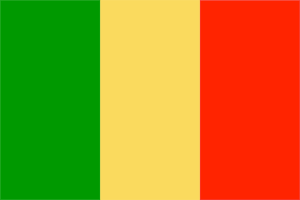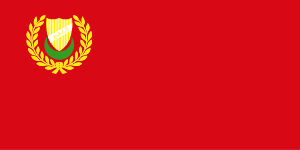Malay tricolour

A tricolour featuring green, yellow and red, is a combination of colours that commonly found in varying designs of symbols adopted by some major organisations to symbolise the Malay people.
Symbolism
The tricolour is derived from the three important values of Malayness; Islam, Malay rulers and Malay culture.[1] The green is the traditional colour of Islam, a faith that has been the integral part of Malay culture. The yellow is the royal colour commonly associated with Malay sultans, and used to allude the allegiance of Malay people to their Rulers.[2] The third colour, red, is the traditional colour in Malay culture,[3] used to denote the courage, bravery, heroism and loyalty.[4] The shade of red nicknamed kesumba red that is identical to scarlet and commonly associated with blood, is the existential colour of the Malays and is the most frequently cited colour in the literature.[5]
The oldest Malay state, Kedah, also adopted the red as its traditional colour.[6]
Usage
Despite having deep roots in Malay traditions, the green, yellow and red as a collective symbolism only surfaced in 1933, when the Royal Malay Regiment was founded. Both the regimental crest and flag bear the tricolour,[7] as soldiers of the regiment swore their allegiance to the Sultans of Malay states, then the protectorates of the British Empire.[8] In 1946, when Malay nationalist movement at its peak, the right wing United Malays National Organisation (Umno) adopted the tricolour in its flag. The party which would lead Malaya to its independence and govern the nation since then, included the additional white band to its flag to symbolise purity.[9] After Umno, the tricolour also appears in the symbols of other right wing organisations like Pekida and Perkasa, and some major Silat associations in Malaysia, including Seni Gayong[10] and Seni Gayung Fatani.
The tricolour also gained popularity among those in the gang population. One of the notorious criminal gangs outlawed by Malaysian government, the Tiga Line ('the three lines'), established its identity based on the tricolour.[11]
Gallery
 Flag of the Royal Malay Regiment.[12]
Flag of the Royal Malay Regiment.[12].svg.png) Flag of the United Malays National Organisation.
Flag of the United Malays National Organisation. Modern flag of Kedah.
Modern flag of Kedah.
References
- ↑ Lemiere 2015
- ↑ Blackburn & Hack 2012, p. 214
- ↑ Che Husna Azhari 1997, p. 55
- ↑ Blackburn & Hack 2012, p. 214
- ↑ Che Husna Azhari 1997, p. 53
- ↑ Kedah State Government 2015
- ↑ Rejimen Askar Melayu Diraja 2015
- ↑ Blackburn & Hack 2012, p. 214
- ↑ Umno Online 2014
- ↑ Pertubuhan Silat Seni Gayong 2013
- ↑ Rahmah Ghazali 2014
- ↑ Rejimen Askar Melayu Diraja 2015
Bibliography
- Blackburn, Kevin; Hack, Karl (2012), War, Memory and the Making of Modern Malaysia and Singapore, National University of Singapore, ISBN 978-997-169-599-6
- Che Husna Azhari (1997), "Teknologi Warna Alam Melayu (Dye technology of the Malay world)", Akademika, Universiti Kebangsaan Malaysia, 51
- Kedah State Government (2015), Profil Negeri - Bendera Negeri ('State profile - State flag')
- Lemiere, Sophie (2015), Gangsta to the roots: Gangsta beyond stereotypes, New Mandala
- Pertubuhan Silat Seni Gayong (2013), Lambang Gayong (Logo of Gayong)
- Rahmah Ghazali (2014), Pekida: We are not rogues, The Star Online
- Rejimen Askar Melayu Diraja (2015), Bendera RAMD (Flag of RAMD)
- Umno Online (2014), Bendera UMNO : ‘Sang Saka Bangsa’ (Flag of Umno: 'Sang Saka Bangsa')